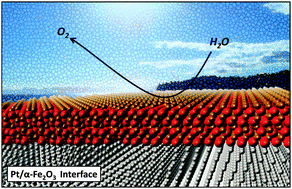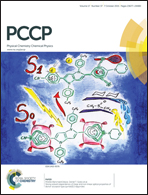Can we judge an oxide by its cover? The case of platinum over α-Fe2O3 from first principles†
Abstract
Metal/metal-oxide interfaces appear in a wide variety of disciplines including electronics, corrosion, electrochemistry, and catalysis. Specifically, covering a metal-oxide with a metal is often thought to enhance solar energy absorption and to improve photocatalytic activity. For example, the platinum/hematite (Pt/α-Fe2O3) interface has demonstrated improved functionality. In order to advance our understanding of how metal coverage over an oxide helps performance, we characterize the geometry and electronic structure of the Pt/α-Fe2O3 interface. We investigate the interface using density functional theory +U, and find a stable crystallographic orientation relationship: Fe2O3(0001)[1![[1 with combining macron]](https://www.rsc.org/images/entities/char_0031_0304.gif) 00]∥Pt(111)[10
00]∥Pt(111)[10![[1 with combining macron]](https://www.rsc.org/images/entities/char_0031_0304.gif) ] that agrees with experiment. Furthermore, there are significant changes in the electronic structure of α-Fe2O3 as a result of Pt coverage. We therefore suggest the concept of “judging” the electronic properties of an oxide only with its cover. Specifically, covering Fe2O3 with Pt reduces carrier effective mass and creates a continuum of states in the band gap. The former could be beneficial for catalytic activity, while the latter may cause surface recombination. In order to circumvent this problem, we suggest putting metal coverage behind the oxide and far from the electrolyte in a photoelectrochemical device in order to quickly collect electron carriers and avoid recombination with vulnerable holes accumulating as a result of catalysis at the surface.
] that agrees with experiment. Furthermore, there are significant changes in the electronic structure of α-Fe2O3 as a result of Pt coverage. We therefore suggest the concept of “judging” the electronic properties of an oxide only with its cover. Specifically, covering Fe2O3 with Pt reduces carrier effective mass and creates a continuum of states in the band gap. The former could be beneficial for catalytic activity, while the latter may cause surface recombination. In order to circumvent this problem, we suggest putting metal coverage behind the oxide and far from the electrolyte in a photoelectrochemical device in order to quickly collect electron carriers and avoid recombination with vulnerable holes accumulating as a result of catalysis at the surface.


 Please wait while we load your content...
Please wait while we load your content...